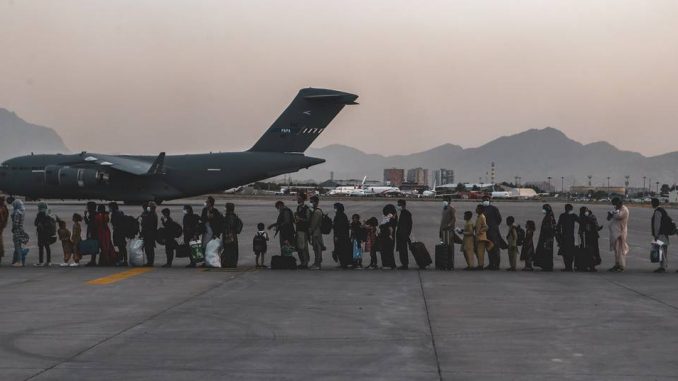
Note: this story has been updated with new information from the Marine Corps about an additional casualty.
Troops on the ground at Hamid Karzai International Airport got 8,000 evacuees out of Kabul on Thursday, according to the deputy director of the Joint Staff for regional operations, in the wake of an ISIS bombing that ripped through the crowds outside he gate, killing dozens and injuring many more.
Twenty-nine C-17 Globemasters and five C-130 Hercules took off amid the chaos and trauma outside the gates, Maj. Gen. Hank Taylor told reporters Friday, with 54 partner country flights getting out another 4,000. Taylor also clarified that, prior to previous reports, it’s now the Pentagon’s understanding that only one bomb went off outside of the airport, near the Abbey Gate.
“I can confirm for you that we do not believe that there was a second explosion at or near the Baron Hotel ― that this was one suicide bomber,” he said. “We’re not sure how that report was provided incorrectly but we do know it’s not any surprise that in the confusion of very dynamic events like this can cause information sometimes to be misreported or garbled.”
So far, casualties among U.S. troops total 13 deaths and 18 wounded. The services have individually confirmed 11 Marine deaths, one soldier and one Navy corpsman, though identities will not be released until 24 hours after their next of kin have been notified.
There are more than 5,000 people on the airfield waiting for flights out, Taylor said, and processing of those lined up outside continues.
With four days left to complete the mission, there have been some changes to the security posture outside the gates, Taylor said.
“Multiple activities have take place to increase the force protection, specifically in communication with the Taliban, in terms of how they are executing their checkpoint operations and communication,” Taylor said.
When asked whether there were changes to the number of troops outside the gates or the surveillance of the crowds, Taylor would only say that they were taking precautions to “not create patterns” that would make it easier to target them.
RELATED
:quality(70)/cloudfront-us-east-1.images.arcpublishing.com/mco/ZRG2VVJJVRBFJJMXTPGEPPYVUU.jpg)
The threat of attacks is ongoing, the head of U.S. Central Command told reporters on Thursday.
“We believe it is their desire to continue those attacks and we expect those attacks to continue, and we’re doing everything we can to be prepared for those attacks,” Marine Gen. Frank McKenzie said. “And that includes reaching out to the Taliban, who are actually providing the outer security cordon around the airfield, to make sure they know what we expect them to do to protect us, and we will continue to coordinate with them as, as they go forward.”
There are still roughly 5,000 troops at the airport, he said, though work has begun for their ultimate withdrawal.
Taylor confirmed Thursday reports that troops on the airfield had begun controlled detonations to destroy equipment that won’t make the journey back home. The priority will be putting people in available space, he said, though he had no details on what had been destroyed.
As those units start flying out, Pentagon spokesman John Kirby said those troop numbers won’t be shared. U.S. Central Command took a similar tack during the larger Afghanistan drawdown, offering a percentage of troops and equipment sent home until they reached about 50 percent.
“Don’t expect daily updates on exactly how many troops are there at any given moment,” Kirby said.
Meghann Myers is the Pentagon bureau chief at Military Times. She covers operations, policy, personnel, leadership and other issues affecting service members. Follow on Twitter @Meghann_MT


Be the first to comment